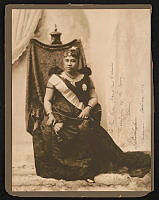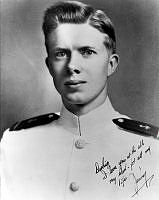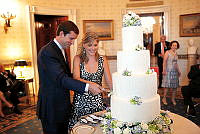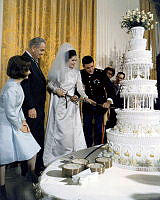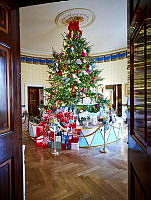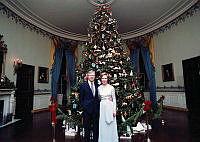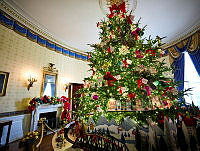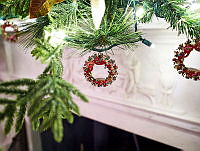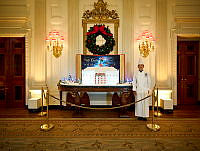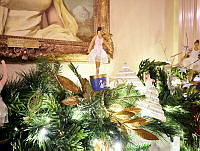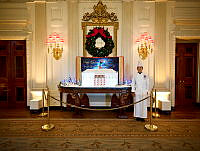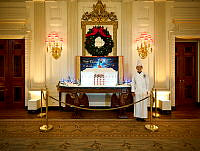
Treasures of the White House: George Washington
800.1290.1
On the afternoon of August 24, 1814, Dolley Madison received word at the White House from her husband the president that the British were about to march on Washington. He urged her to leave quickly. The British troops set fire to the Capitol Building that evening, then a naval contingent moved on to the White House. While the naval officers ate the dinner that had been laid out for the Madisons, the sailors explored the house. After piling up the furnishings, they set them ablaze. The President's House was reduced to a shell, its contents consumed by the fire.
But Mrs. Madison had been determined that, in addition to official papers, the full-length portrait of George Washington painted by Gilbert Stuart must be kept from British hands. There was no time to unscrew it from the wall, so the frame was broken and the canvas on its stretcher carried from the house into the safety of the countryside. Not until 1817 was it returned to the rebuilt White House.
Although others had painted George Washington as military hero, it remained for Gilbert Stuart to create the authoritative image of the first president. No other portrait so conveys the unyielding resolve and severe dignity that made him the embodiment of the young Republic. Washington grasps a sheathed sword, emblematic of his military past and his present position as Commander in Chief. His civilian clothes remind us that after the peace was achieved in 1783 and the army disbanded, he had resigned his commission. This renunciation of power was so novel that it astonished Europeans as well as his own countrymen. A folio volume of the Constitution and Laws of the United States leans against (symbolically, supports) the table leg whose design joins elements of the fasces – the bound rods that symbolized authority and justice in the Roman republic–and the American eagle. Next to the Constitution is a history of the American Revolution. We know from another version of the portrait that the title of the book next to that one is Washington's General Orders, also recalling his military career. Likewise, the two books on the table are The Federalist and The Journal of Congress. These remind us of his steadfast support of the federal union and its Constitution.
The President's right arm is extended in one of the ancient Roman oratorical gestures, through which it echoes the ideals of the Roman republic. But the arm has been lowered and an imperious gesture modified by the contemporary English model of "conversation-piece" paintings in which men and women converse as equals.2 This is the man who had addressed Congress at his 1789 inaugural as "fellow-citizens."
Garry Wills, in Cincinnatus: George Washington and the Enlightenment, has deftly summarized most of the other symbolic elements in this painting:
Stuart's portrait derives from the grand manner style of court painting in Europe during the 17th and 18th centuries; the artist borrowed freely from an engraving of a late 17th-century French portrait in composing this painting. But by introducing different objects and symbols and by substituting an attitude of plain speaking for one of aristocratic hauteur, Stuart changed the meaning of the borrowed forms.
Washington never posed for the standing figure. This was in accordance with standard portrait practice: The sitter posed for the head only, with perhaps some quickly drawn notations of the torso and the extremities, while the body was painted from a surrogate model or even invented. The White House portrait is probably' the last of four nearly identical versions painted by Stuart, though there is no unanimity on the order in which the portraits were created. Since one of the four was painted as a gift to the Englishman Lord Lansdowne, all four are commonly referred to as being of the "Lansdowne type." The head derives from a sitting in April 1796, requested specifically for use in painting the first full-length portrait.
Source: William Kloss, et. al., Art in the White House, New York: Abrams, 1992.
- Artist
- Gilbert Stuart (1755–1828)
- Medium
- Oil on canvas, 95 x 59 13/16 inches (241.3 x 151.9 cm)
- Credit
- United States Government purchase, 1800













